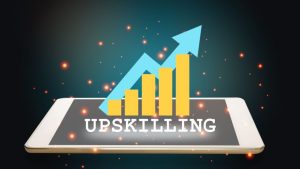The Art of Career Reinvention: Transforming Your Path to Success
 Publié le 28 November 2023
Publié le 28 November 2023
You can master the art of career reinvention to transform your path to success.
Let’s look at your career path a little differently today. If you’ve clicked on this article, it’s likely you’ve been feeling restless lately. Your job isn’t challenging anymore, no longer fun, or you simply have to admit there’s something else you desperately want to be doing. In other words: you want to change your career.
But there are so many buts. Is now the right time? With all these layoffs, the new house, that promotion that’s been luring, or whatever it is that’s holding you back?
Chances are, you’re holding yourself back. We have a tendency to look at our careers as being as fragile as expensive wine glasses. When in fact, our careers are more malleable than ever.
In this article, we’ll explore how you can make both mental and practical steps to creating a future that works for you, one job at a time. Through the art of career reinvention, you can learn the steps for transforming your path to success in your professional life.
First…your mindset around a career change
Many people complain about the market when reasoning about why they are staying put, while often, it’s mostly their mindset that is the limiting factor.
Sure, realistically, you will have to look at what the demand and supply is in the industry and the role you’re aiming for. But just because it’s not the most booming of businesses and companies are desperately hiring, doesn’t mean you should just let go of your dreams.
Let’s explore some of the hurdles you might encounter, and how you could change your way of thinking.
The cost-benefit analysis of changing things up
Don’t just think in terms of money (but also very seriously do think in terms of money, separately). What is the emotional and psychological cost of not pursuing a career change when you know you need it?
This will largely depend on the reason you’re pursuing a change. If it’s because your current job is burning you out, staying put could be a lot more expensive in the long run.
The stigma of starting over when you’ve built a career
Maybe you’re already quite high up one ladder, but you want to be on a completely different ladder – no matter how high. This is often where extensive experience can become a double-edged sword.
Look at ways you can leverage your experience, instead of letting it hold you back. Unless you want to move from being a carpenter to a surgeon, chances are some of the transferable skills you’ve learned, and even learning strategies you used will be useful in your new career.
‘Leverage your experience without being pigeonholed by it.’
You are not your career
Here’s a trick: adopt an entrepreneurial mindset in career reinvention, even if you’re not starting a business. It works to see your career as your business. See it as something you’re working on, rather than something you are.
‘Take a step back and unglue yourself from your career: you are not your career, but you are the one building it.’
Taking stock of your skills and goals
After these exercises of the mind, it’s time to get into gear and look at the practical side of things.
A thorough risk assessment
What does a genuine, no-holds-barred risk assessment look like if you’re going ahead with a career pivot? How do you balance the fear of financial insecurity with the potential for personal fulfillment? There’s tons of DIY advice out there, but ultimately it’ll depend on your personal situation. When in doubt, work this out with a financial advisor or someone else who understands the consequences and can guide you forward.
Checking in on yourself with a self-evaluation
Self-evaluation is about looking into the mirror—not just to see who you are, but to reflect on who you could become.
Let’s start with the basics? What is a self evaluation? Don’t confuse it for a traditional performance review done by your managers or peers – for this one, you’ll be judging yourself.
With a self-evaluation, the aim is to identify your strengths, weaknesses, passions, and peeves – and tie them all into your true self. With traditional performance reviews, you are often reviewed in relation to your specific role. A self-evaluation aims to look at you separately from that role, to find what you’re truly good at and care about – to find a place where you can put that passion to work. It asks broader questions, such as:
- What tasks do you find energizing?
- What accomplishments are you most proud of, and why?
- Where do you see yourself adding the most value?
- What skills have you acquired or improved upon in the last year?
Start asking yourself questions like these daily. You can keep your answers in a journal, or in a spreadsheet, if that’s your thing, and ultimately use it to guide your next steps.
Identifying where to go next in your career
Time for the next step. If your self-evaluation reveals a passion for creative problem-solving, but you’re stuck in a role that doesn’t utilize that skill, your pivot could involve seeking out careers or industries where this talent of yours is valued. Or perhaps you discover that you have a strong independent streak, which could mean that freelancing or entrepreneurship could be your calling.
But that’s just part of the puzzle. Let’s look at what else you can consider to figure out where to go next.
Making a forward or sideward career move?
In some cases, it’s wise to make a lateral move instead of making a big leap. Let’s look at some scenarios.
A lateral move might be best if it gives you the opportunity to learn a new set of skills, a different type of experience, or entry into an industry where your passion lies. Don’t see it as a step back or something negative – this could be exactly the strategic move you need to make to position you for a future checkmate.
A sidestep might also alleviate the pressure that we’re sure has built up and provide a learning curve that is not as steep – giving you time, space and confidence to build strength.
Here’s when to consider a lateral move:
- If it offers exposure to new areas of business where your desired skills are more relevant.
- If it allows you to work in a more innovative environment or with teams that can teach you.
- If it provides a better work-life balance, allowing you to cultivate personal growth that aligns with professional ambitions.
Don’t get us wrong: big leaps have their place too – especially if you’re pivoting to a role or industry that’s dramatically different and where the entry level positions don’t align with your experience.
Dare to take that leap when:
- You’ve gathered enough transferable skills that would be useful in a higher role – even if it’s a brand-new industry to you.
- There’s an opportunity that’s up for grabs that might not come around again.
- You’ve built up a financial buffer and are emotionally prepared to take on the risk.
The aim of the game here is to help you see that the idea of a linear career path is outdated. There’s no need to limit yourself to certain positions that only help you go higher up in the same chain. You can (and should!) apply to a new job that excites you, even when you don’t meet the exact criteria.
Crafting your narrative with a one-page resume
It might feel strange to boil all this hard inner work down to a single page of information, but it’s what needs to be done.
A strong (not long!) resume will show your cross-industry skill transferability and get people interested in you. Here are some tips to keep in mind:
- Kick things off with clarity: spend some time compelling a clear headline that doesn’t just state your current job title or what you do, but also encapsulates what you want to do.
- Lead with your strength: stick to the strongest ones, and the most relevant ones. If you’re already in a senior position, assume people know you’ve got the basics covered – don’t clutter up your resume with them.
- Highlight relevant projects and roles: underscore your impact and quantifiable outcomes to make it more practical, even for someone who isn’t in your industry.
- Design for readability: 20 years of experience on one page can feel a bit cramped. Check out these samples of one-page resumes to see how you can keep your resume easy to scan.
Rounding up: how do you know you made the right choice?
Whether or not you’ve made the right choice doesn’t just become clear in your new LinkedIn headline or bank statements. You should also take your sense of alignment and purpose into account.
But it all starts with actually taking the decision, and following it up with a true commitment. Without full dedication, any career move will be a half-hearted attempt, and its success or lack thereof will be a poor indicator of its (and your) true potential.
A career move should be taken with enough consideration, but make sure you look at it from various perspectives – not just from behind the roadblocks.
Are you considering making the move? You can use the art of career reinvention for transforming your path to success and find a great new career path.







